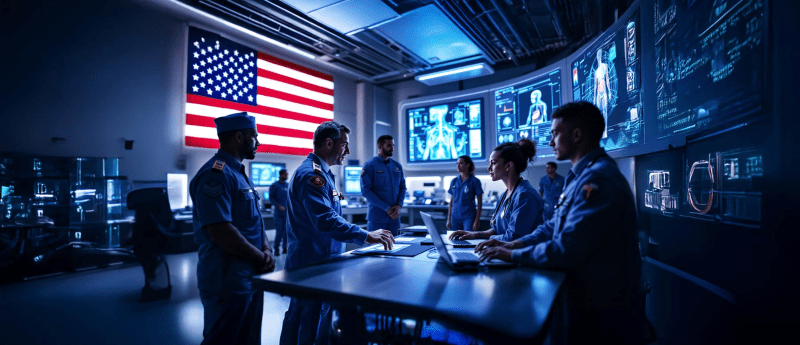U.S. Military Concludes Pilot for Medical AI

The U.S. Chief Digital and Artificial Intelligence Office (CDAO) has finalized a crowdsourced pilot program to test the potential use of AI in military medicine.
The initiative, called “Crowdsourced AI Red-Teaming (CAIRT) Assurance Program”, aimed to assist the Department of Defense (DoD) in exploring the applications of Large Language Models (LLMs) to enhance clinical note summarization and provide medical advice for the military.
What is the CAIRT Assurance Program?
The CAIRT assurance program, developed by the CDAO, was designed to leverage AI capabilities across the DoD. It sought to develop strategies for AI assurance and risk mitigation in military medicine while examining how chatbots could assist in improving healthcare services for military personnel.
Conducted by the technology firm Humane Intelligence, in collaboration with the Defense Health Agency (DHA), and the Program Executive Office, Defense Healthcare Management System.
The program engaged over 200 participants who took part in the exercise, including clinical providers and healthcare analysts from the DHA, as well as the Uniformed Services University of the Health Sciences, and various military personnel.
The exercise used crowdsourcing to engage a diverse range of stakeholders. Participants compared three leading LLMs and assessed their performance to identify potential flaws in their functionality.
To detect system weaknesses, Humane Intelligence used red-teaming methodology, which is a practice that stimulates non-destructive cyberattacks to test system robustness, was employed to detect weaknesses in the AI systems.
The findings of the CAIRT program revealed more than 800 vulnerabilities and biases associated with using AI chatbots in tasks such as clinical note summarization and providing medical advice.
Application of AI in Military Medicine
One of the key applications of AI lies in clinical decision support, where AI algorithms assist healthcare providers in diagnosing and treating patients, improving clinical efficiency and streamlining routine decision-making. AI tools have been developed for medical scribing, such as Suki, as well as for generating handoff notes in emergency medicine.
Moreover, AI can contribute to health monitoring and biosurveillance by continuously monitoring health indicators. The DoD is developing The Biosurveillance Ecosystem (BSVE). The BSVE is a cloud-based system that integrates data from various sources, including open-source information, social media, diagnostic data, and surveillance systems, to provide real-time analysis and early warning of potential disease outbreaks.
AI offers transformative potential across numerous facets of military medicine, including patient and resource management, triage, and medical product development. By streamlining operations and enhancing decision-making, AI not only addresses critical challenges but also drives innovation in medicine, including military medicine.
Military Medicine: A Vital Sector in Need of Strengthening
The U.S. military has a long-standing reputation for driving innovation. During operations such as “Enduring Freedom” and “Iraqi Freedom” in the 2000s, the military spearheaded major innovations in military technology and healthcare.
However, concerns have arisen about the possibility of escalation of the current conflicts in Ukraine and the Middle East, which would potentially lead to significant strains in the American military healthcare system.
AI has already proven transformative in civilian healthcare, advancing fields such as cancer research, Extended Reality therapy and pathology disease diagnoses. Its application in military medicine could similarly revolutionize U.S. military medicine.
The CAIRT program, along with its evaluation of AI tools applied to military healthcare, holds the potential to drive significant improvements in the near future.
By creating benchmark datasets, the results of the CAIRT program could be repeated, expanded or used for further comparisons to improve military medical care. These datasets could be used to assess future vendors and tools to ensure they meet performance expectations. Additionally, the program´s insights could be instrumental in guiding DoD policies and establishing best practices for the responsible use of AI.
“This program acts as an essential pathfinder for generating a mass of testing data, surfacing areas for consideration, and validating mitigation options that will shape future research, development, and assurance of GenAI systems that may be deployed in the future”
Dr. Matthew Kuan Johnson, CDAO’s lead for the CAIRT program.
What is the Future of AI in the Military?
AI is increasingly being explored for its potential to enhance military operations across various contexts. For example, recently, tech giant Meta recently made its AI model, Llama, accessible to the U.S. military and defence suppliers.
Maintaining a technological edge in AI is critical for the U.S., especially given growing tensions with China, which is rapidly emerging as a global AI hub.
In response, the U.S. government has been imposing restrictions on the export of AI chips to China and other countries, concerned about their use in military advancements.
The bipartisan U.S.-China Economic and Security Review Commission recommended that AI projects be treated as a top national priority by the U.S. Secretary of Defense.
In military medicine, however, the use of AI remains in its infancy. While the CAIRT program holds significant promise for advancement, the errors identified cannot be overlooked for its use in a sector where accuracy is paramount.
Continued testing and refinement of LLMs and AI systems will be essential to unlocking their full potential and accelerating the CDAO’s AI capabilities. Through the ongoing efforts of the CAIRT Assurance program, the DoD can build confidence in AI systems, enhance their reliability, and ultimately improve military healthcare outcomes.